Sukhoi Superjet 100
| Superjet 100 | |
|---|---|
_over_Italy.jpg) | |
| A Superjet 100 flying off the coast of Italy near Sanremo | |
| Role | Regional twin-engine jet airliner |
| National origin | Russia |
| Manufacturer | Komsomolsk-on-Amur Aircraft Production Association |
| Designer | Sukhoi |
| First flight | 19 May 2008[1][2] |
| Introduction | 21 April 2011 with Armavia |
| Status | In service, in production |
| Primary users | Aeroflot Interjet Yamal Airlines Gazpromavia |
| Produced | 2007–present[3] |
| Number built | 169 as of 30 July 2018[4] |
| Program cost | US$ 1.5 billion[5][6] |
| Unit cost | |
| Developed into | Sukhoi Superjet 130 |
The Sukhoi Superjet 100 (Russian: Сухой Суперджет 100, tr. Sukhoy Superdzhet 100), also known by its abbreviation SSJ100,[11] is a fly-by-wire twin-engine regional jet with 8 (VIP)[12] to 108 (all economy) passenger seats.[13] With development initiated in 2000, the airliner was designed and spearheaded by Sukhoi, a division of the United Aircraft Corporation, in co-operation with several foreign partners. Its maiden flight was conducted on 19 May 2008. On 21 April 2011, the Superjet 100 undertook its first commercial passenger flight, on the Armavia route from Yerevan to Moscow.
Sukhoi claims cash operational costs lower by 8-10% than competitors, reduced fuel burn per seat and higher maintenance intervals.[8] It is designed to compete internationally with its An-148, Embraer E-Jet and Airbus A220 counterparts.
The final assembly of the Superjet 100 is done by Komsomolsk-on-Amur Aircraft Production Association. Its SaM-146 engines are designed and produced by the French-Russian PowerJet joint venture and the aircraft is marketed internationally by the Italian-Russian SuperJet International joint venture.
Design and development
Background
Development of the Sukhoi Superjet 100 began in 2000.[14] On 19 December 2002, Sukhoi Civil Aircraft and Boeing Commercial Airplanes signed a medium-term Cooperation Agreement to work together on the design. Boeing consultants had already been advising Sukhoi for a year.[15] On 10 October 2003, the technical board of the project selected the suppliers of major subsystems.[16] The project officially passed its third stage of development on 12 March 2004, meaning that Sukhoi could now start selling the Superjet 100 to customers.[17] On 13 November 2004, the Superjet 100 passed the fourth stage of development, implying that the Superjet 100 was now ready for commencing of prototype production.[18] In August 2005, a contract between the Russian government and Sukhoi was signed. Under the agreement, the Superjet 100 project would receive 7.9 billion rubles of research and development financing under the Federal Program titled Development of Civil Aviation in Russia in 2005–2009.[19]
Requirements
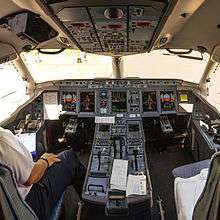
In the Russian domestic market, the Sukhoi Superjet 100 (SSJ) is intended to replace the aging Tupolev Tu-134 and Yakovlev Yak-42 aircraft.[20] Internationally, the new Superjet 100 will compete against the Embraer E-Jets and the Bombardier CRJ programs. The SSJ aims for lower operating costs than its competitors for the price of $23–25 million.[21] According to Sukhoi, ongoing certification tests confirmed that the aircraft's direct operating costs are 6–8% lower than those of its key competitor, the Embraer 190/195.[22] In terms of total fuel burn per sector, the SSJ is on a par with the Antonov An-148 but can accommodate 22 more passengers.[22]
The aircraft's design meets the specific requirements of airlines in Russia, the CIS, the United States and the EU, and conforms to the Aviation Rules AP-25, FAR-25, JAR-25 requirements and to the ground noise level requirements under ICAO Chapter 4 and FAR 36 Section 4 standards entering into force during 2006. From the beginning, the SSJ has been designed to meet all Western aviation standards.[23]
The Superjet uses PowerJet SaM146 turbofan engines developed by PowerJet that provide 60 to 78 kilonewtons (13,000 to 18,000 lbf) of thrust.[24] The noise and emissions levels satisfy the existing ICAO requirements.
Industry participation
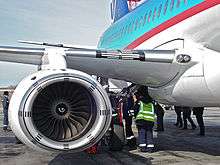
The Superjet 100 has been described as the most important and successful civil aircraft program of the Russian aerospace industry.[25] It enjoys considerable support from the Russian Ministry of Industry and Trade, which regards it as a top priority project.[26] Excluding the SaM146 engine, development of the Superjet 100 cost about $1.4 billion, with 25% of this amount funded from the federal budget.[27] The Superjet 100 is the first new civil non-amphibious jet aircraft developed in post-Soviet Russia.[28]
Over 30 foreign partnership companies are involved in the project. Development, manufacturing and marketing of the aircraft's SaM146 jet engine is being done by the PowerJet company, a joint-venture between the French Snecma and Russia's NPO Saturn. SuperJet International, a joint venture between Leonardo-Finmeccanica and Sukhoi is responsible for marketing in Europe, the Americas, Africa, Japan and Oceania.[25]
The assembly line for all versions of the Superjet is located in the facilities of Komsomolsk-on-Amur Aircraft Production Association (KnAAPO) in the Russian Far East, while Novosibirsk Aircraft Production Association (NAPO) focuses on component production. The two companies have been heavily investing in upgrading of their facilities and were expected to produce 70 airframes by 2012.[25]
.jpg)
Flight testing
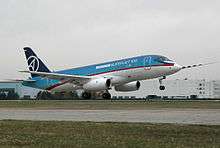
On 28 January 2007, the first SSJ was transported by an Antonov 124 from Komsomolsk-on-Amur to the city of Zhukovsky near Moscow for ground tests.[29] A representative of Sukhoi Civil Aircraft announced on 13 November 2007, the completion of static tests necessary for conducting the first flight. The Superjet was unveiled at its official rollout at Komsomolsk-on-Amur Dzemgi Airport on 26 September 2007.[30]
In February 2008, initial test runs of the SaM146 engine were successful.[31] An Ilyushin Il-76 LL testbed, operated by the Gromov Flight Research Institute, was also used in the engine testing.[32][33] On 19 May 2008, the first test flight of the Superjet took place from Dzemgi airport, at the Komsomolsk-on-Amur Aircraft Production Association.[2]
In July 2008, testing continued successfully.[34] By October 2008, the first stage of Sukhoi Superjet 100's factory-based flight testing program was successfully completed. The second SSJ100 prototype had also been flown and the certification process was started.[35] In December 2008, the second of four SSJ100 prototypes SN95003 took to the skies.[36] The aircraft performed standard stability and handling quality tests as well as systems checks in accordance with the first flight assignment. Flight test engineers and pilots were pleased with the overall performance of the second prototype.[37]
The deliveries were first scheduled to begin in late 2008, and Sukhoi predicted that 3 units of all variations of the Superjet 100 would be delivered by the end of 2008.[38] On 7 July 2008, Sukhoi officially confirmed that the original schedule was too optimistic, and first deliveries would begin in December 2009.[39][40]
.jpg)
As of January 2009, the first two aircraft had completed over 80 flights, totaling around 2,300 hours in flight and ground tests.[41] On 1 April 2009, two Superjet 100 prototypes, 95001 and 95003, successfully completed the first long-distance flight for this aircraft, covering a distance of 3,000 kilometers from Novosibirsk to Moscow.[42] On 17 April 2009, EASA pilots performed the first test flights on the two prototypes. According to EASA pilot feedback, the aircraft was easy to fly.[43] On 26 July 2009, the third of four SSJ100 prototypes (SN95004) flew.[44]
At the Paris Air Show 2009, Malév Hungarian Airlines said that it would purchase 30 Superjets worth $1 billion, providing a welcome boost to sales as it made its international debut at the 2009 Paris Air Show.[45]
As of June 2009, 13 aircraft were under construction with the first four scheduled to be handed over to clients by the end of 2010. After 2012, the company will build 70 Superjets per year.[45] Armenian Armavia would receive the first two aircraft, followed by Aeroflot, which has ordered a total of 30 aircraft with an option for 15 more. Other customers include Russia's Avialeasing company, Swiss Ama Asset Management Advisor and Indonesian Kartika Airlines.[45]
On 29 December 2009, United Aircraft Corporation head Alexei Fyodorov said that deliveries of the Superjet 100 have been indefinitely delayed because the engines were not ready.[46] On 4 February 2010, the fourth prototype SSJ flew. Owing to delays in production of the engines, including quality problems at the NPO Saturn factory, it used the engines removed from the first prototype.[47] On 28 May 2010, all engine tests necessary for certification were completed. The final trial was a simulation of an encounter with a flock of birds.[48]
Flight management system (FMS) tests were completed on 19 November 2010. The FMS CMA-9000 was developed by Canada's Esterline CMC Electronics for the Thales avionics suite.[49]
Certification
On 6 July 2010, Deputy Industry and Trade Minister Denis Manturov, who heads the commission to monitor the implementation of the Sukhoi Superjet program, wrote to Industry and Trade Minister Viktor Khristenko about the progress of the aircraft's certification in early June. Data from 28 May 2010 showed that the certification process was getting behind schedule with most of the problems related to the SaM146 engine, developed by PowerJet, which is a joint project between the Russian Saturn and the French Snecma. Work on its final design had been almost completed and certification was more than 90 percent completed, but problems remain, noted Manturov.[50]
In September 2010, the CEO of SuperJet International said that certification was expected in November 2010.[51] In October 2010, the Sukhoi Superjet 100 (SN95004) passed noise testing carried out under the auspices of Russian and European certification authorities (AR IAC and EASA respectively).[52] On 4 November 2010, the first production Superjet (SN95007) intended for Armavia was test flown.[53]
By November 2010, the SSJ test fleet had flown 2,245 hours during 948 flights.[54]
On 21 December 2010, Superjet 100 passed emergency evacuation and interrupted takeoff tests at Ramenskoye Airport near Zhukovsky, near Moscow, under the supervision of the Interstate Aviation Committee Aviation Register (AR IAC) and the European Aviation Safety Agency (EASA). The first test required 98 volunteers of different age groups and five crew members to evacuate the aircraft in 90 seconds during an simulated emergency landing. They made it in 73 seconds. The interrupted takeoff test probed the wheels, tires and brakes at maximum possible braking speed, without a thrust reverser.[55]
On 3 February 2011, the Interstate Aviation Committee (IAC IR) granted a Type Certificate for Sukhoi Superjet 100.[56] The Type Certificate confirms compliance of the SSJ100 with the airworthiness regulations and it authorizes the commercial operation of the airliner.
On 3 February 2012, the European Aviation Safety Agency (EASA) issued Type Certificate A-176 for the Sukhoi Superjet 100 (model RRJ-95B), confirming that the aircraft complies with the EASA airworthiness and environmental requirements. The certification also makes it possible for airlines operating in countries using EASA rules to accept and operate the aircraft. The extensive validation program included several dedicated flight and ground tests.[57]
In service developments
London City Airport is a major destination for Irish CityJet, which is receiving 15 SSJ100s, but its steep 5.5° approach requires new control laws, wing flap setting and modified brakes: test flights will begin in December 2017, certification is planned for 2018, and the modified aircraft will be available in 2019.[58]
A new "sabrelet" winglet, helping takeoff and landing performance and delivering 3% better fuel burn, will be standard and available for retrofit.[58] Designed with CFD tools by Sukhoi and TsAGI, the “saberlets” debuted flight tests on 21 December 2017. They should improve hot and high airport performance and cut costs up to $70,000 per year. Parts of the wing are reinforced for the aerodynamic loads distribution change.[59]
Russified SSJ
Sukhoi's plans a 'Russified' Superjet 100 for 2020: a smaller PD-10 variant of the Aviadvigatel PD-14 could be developed, and Russian inertial navigation system and APU could replace Honeywell's, as Safran produce its landing gear.[60] Russian content should double to 30% as US restrictions limit its export potential. Sukhoi forecasts 345 sales from 2018 to 2030, mostly in post-Soviet states and some in south-east Asia and Latin America, including an improved range business jet version. Sukhoi expects to produce 30 in 2018, like in 2017. Its seating capacity is raised to 110 and hot and high operations to 4,000m and 50°C as a freighter variant is studied.[61]
The Kremlin has earmarked ₽3.2 billion ($51 million) toward the SSJ100R with indigenous propulsion and avionics, introduced at the Eurasia Airshow 2018 in Antalya along the SSJ75. Sukhoi Civil Aircraft lost 5 billion roubles in two years, raising its debt to 25.3 billion roubles but hopes for more sales from Iranian airlines to replace Boeing, Airbus, and ATR orders cancelled with the U.S. withdrawal from the Iran nuclear deal. With 30 yearly deliveries, UAC claims a 37.5% market share of 80-120 seaters, or 19% of the regional jet market. For three years from 2018, UAC plans to invest ₽13.3 billion ($212 million) for the SSJ.[62] On 12 July, while evaluating the winglets, the right landing gear failed to release fully, the test aircraft dumped fuel and made an emergency landing with no injuries at the Gromov Flight Research Institute, it will be repaired and returned to flying.[63]
To resist the Airbus-Boeing duopoly pressure on regional jets through the Embraer E-Jet E2 and the Airbus A220, Sukhoi upgrades the SSJ100 as the SSJ100B and the "Russianised" SSJ100R. The SSJ100B would feature more powerful SaM146-1S18 engines, improved avionics software, enhanced high-lift devices controls and retrofit-able "sabrelets" blended wingtip devices. Its navigation system would be tested in the North Pole. The SSJ100R western components are replaced by Russian ones for governments and Western-sanctioned countries.[64]
Western content accounts for 55-60% of an SSJ100 cost but sanctions against Russia are tightening. Replacing US parts like INS, APU, and cabin by Russian or European substitutes will allow deliveries to Iran Air Tours and Iran Aseman which signed letters of intent for 40 in 2017, but European partners will not risk US retaliation. After 2021 the SSJ100R will be produced without Western components: the Thales avionics would be replaced by KRET ones and the SaM.146 engines by a PD-9 scaled down Aviadvigatel PD-14, reducing fuel burn by 5-8% with a new composite wing.[65]
Orders and deliveries
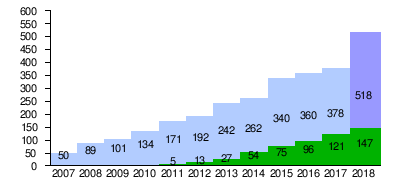 |
| As of 30 April 2018 |
| 2005 | 2006 | 2007 | 2008 | 2009 | 2010 | 2011 | 2012 | 2013 | 2014 | 2015 | 2016 | 2017 | 2018 | Total | |
| Orders | 40 | 6 | 4 | 39 | 12 | 33 | 37 | 21 | 50 | 20 | 78 | 20 | 18 | 140 | 518 |
| Deliveries | - | 5 | 8 | 14 | 27 | 21 | 21 | 25 | 26[66] | 147 | |||||
Operational history
Introduction
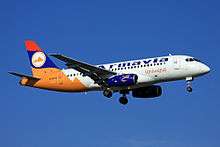
The first production Sukhoi Superjet was delivered to Armavia on 19 April 2011. The handover ceremony was held at Zvartnots International Airport in Yerevan on the same day.[67] The aircraft was named "Yuri Gagarin", after the first man to venture into space almost exactly 50 years before.[68] Armavia planned to operate its Superjet 100 on flights between Yerevan, Sochi and Ukrainian cities,[67] including Odessa and Simferopol. The airline had expected to receive its second Superjet in June 2011.[69]
On 21 April 2011, the first commercial flight of Sukhoi Superjet 100 (SN 95007) by Armavia airline landed at Sheremetyevo International Airport, Moscow at 04:45 MSK (00:45 GMT), carrying 90 passengers from Zvartnots International Airport, Yerevan.[69][70][71] The flight took about 2 hours and 55 minutes.[69]
Armavia used the Airbus A319 on its Yerevan to Moscow (SVO) route and had a plan to switch to the Superjet 100.[69] In August 2012 Armavia announced that they had returned both of its SSJ-100s to the manufacturer.[72]
The president of United Aircraft Corporation and general director of Sukhoi Mikhail Pogosyan hailed the event as a key milestone for the Superjet 100 project, saying that it opened "a new stage of the program — the beginning of commercial operation and full-scale serial production."[70]
The aircraft was put into commercial operation within an unprecedented short time after delivery. For the first week of service the SSJ-100 accumulated 24 flights, flying to Moscow, Athens, Donetsk, Aleppo, Tehran, Tel Aviv, and Astrakhan. On 1 May, the Superjet made its first regular flight to Venice (2,800 kilometres (1,700 mi), approx 3 hour and 45 minute flight).[73]
Initial operations
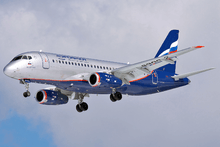
In March 2012, the deputy chief engineer of the Department of Aviation and Technical Support of "Aeroflot" Constantine Mohniit revealed in the Russian daily newspaper Vedomosti, that Aeroflot was asking Sukhoi for compensation since the six Superjet 100s it operates are in the air only 3.9 hours/day on average instead of the standard 8 to 9 hours. Breakdowns "... were caused by failures due to technical problems and delayed delivery of parts."[74]
In February 2013, SCA stated in a press release that such problems are usual in newly operational and recently introduced airliners and minimized the claims.[75]
At the end of October 2013, Interjet confirmed outstanding results in terms of operations.[76] As of 31 October, the two Interjet SSJ100 have completed almost 600 flight hours, over 580 flight cycles during their commercial operations, with an average daily usage of 9.74 block hours, and a dispatch reliability of 99.03%.[77][78] Dispatch reliability of Interjet's fleet of seven SSJ100 increased to 99.7% as of June 2014.[79]
On 16 December 2012, Mikhail Baghdasarov, owner of bankrupt Armavia, stated that both of its ordered airplanes had been returned to Sukhoi Civil Aircraft company. He was also quoted as saying "that the SSJ-100 is not operated by the company anymore, Sukhoi Civil Aircraft has possession of the jet, and Armavia had decided not to receive any aircraft."[80] Armavia's website did not show that it is not operating Sukhoi Superjet 100s as of February 2013. However it ceased operations in March 2013[81]
International operations
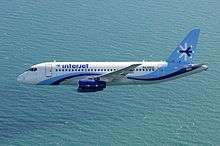
On 12 September 2014 Interjet started regular passenger flights to the U.S. on the Monterrey, Mexico (MTY) – San Antonio, Texas (SAT) route.[82][83] The Mexican air carrier also currently operates the aircraft in scheduled service between Monterrey and Houston George Bush Intercontinental Airport (IAH).[84]
On 2 June 2016 at approximately 18:30 the first SSJ100 for CityJet landed at Dublin Airport. This represented the first delivery of a new aircraft, of any type, for CityJet.
Dependability
.jpg)
On 24 December 2016, the Russian aviation regulatory agency grounded six SSJ100s operating in Russia after metal fatigue was found in a tail component of an aircraft operated by IrAero, leading Sukhoi to begin inspections of the entire in-service SSJ100 fleet.[85] All SSJ100s were inspected by SCA on 27 December 2016. Following the results of the inspection, it was stated that the defect was not of a systemic nature and could be eliminated within a few days. The replacement of nodes on the aircraft with the defect identified (5 Aeroflot and 1 IrAero) would be completed by late January 2017. Examination confirmed that the issue was not a critical situation: the node features a multi-level redundant structure and has a safety margin which is more than twice the operational loads.[86] All Mexican SSJ 100 were also inspected.[87]
In June 2017, dispatch reliability increased to 97.85% from 96.94% a year earlier, while there were 89.6 malfunctions per 1,000 flight-hours, 40% fewer.[88] On 21 July 2017 the European Aviation Safety Agency mandated a compulsory horizontal stabilizer rear spar inspection following the discovery of cracks on Sukhoi Superjet 100-95B aeroplanes in service on the rear spar of the horizontal stabilizer between ribs 0, 1 and 2.[89] Sukhoi recognises it needs to improve customer support with more responsiveness and availability for flight training, engineering and spare parts supply.[58]
In January 2018, Bloomberg reported that four out of 22 of Interjet's SSJ100s were cannibalized for parts to keep others running after having been grounded for at least five months because of SaM146 maintenance delays.[90] This was later refuted by Interjet.[91] One grounded SSJ100 is going to be back in service on 19 January and the remaining three in March.[92]
In August 2018, Russian regional carrier Yakutia Airlines considered withdrawing their SSJs as two were grounded because their engines were removed after 1,500-3,000 cycles, below the 7,000 specified, and no replacements were available. PowerJet was expanding its repair capacity and lease pool as engine maturity improved, noting the SaM146 engine achieved 99.9% dependability since its 2011 introduction.[93]
In September 2018, Interjet was reported to be considering replacing its SSJ100s with Airbus A320neos, to make better use of its slots, with the SSJ technical problems possibly also a factor.[94] This would have left CityJet as the only remaining Western customer.
On 12 September, Interjet denied the report.[95] It was later reported that Interjet intends to phase out some of its Superjets and take 20 more Airbus A320neos, maybe alongside newer Superjet deliveries, and will have access to an enhanced SSJ spares inventory in Mexico City and is installing a flight simulator in Toluca.[96] The updated jets would have winglets, a higher MTOW and improved systems and interior.[97] Sukhoi has also proposed to increase the cabin density from 93 to 108 seats by reducing the pitch from 34 to 30 in (86 to 76 cm).[98]
Interjet claims its capital cost for 10 Superjets is equivalent to the pre-delivery payment for one Airbus A320.[99] The pre-delivery payment amounts to 15-30% of an aircraft list price.[100] An A320 list price was $88.3M in 2012.[101]
By September 2018, Brussels Airlines was seeking alternatives for its four SSJ100s wet-leased from CityJet until March 2019, as teething problems affected their reliability.[102]
In October 2018, Sukhoi and engine contractor UEC agreed a plan, backed by the Russian government, to focus on customer support rather than deliveries in order to improve dispatch reliability.[103]
Development
By August 2016, 133 SSJ00s were in operation with eight airlines and five governmental and business aviation organizations.[65] In summer 2017, the business jet variant's additional fuel tanks were certified to carry 3,100 kg (6,800 lb) more fuel, increasing range from 4,420 km (2,390 nmi) to 6,000 km (3,200 nmi). In early November 2017, the Russian Federal Air Transport Agency and Italian Civil Aviation Authority (ENAC) amended their bilateral airworthiness agreement, hitting its export sales. At least 30 SSJ100s should be delivered in 2017, increasing to 38 in 2018 and 37 in 2019.[104]
In October 2017, there were 105 SSJ100 in service worldwide: some used by governments of respective countries such as the Royal Thai Air Force and Kazakh government agencies. The fleet logged 230,000 flights in 340,000 hours since its commercial operations debuted in 2011.[104] In May 2018, ten years after its first flight, the fleet of 127 have logged over 275,000 commercial flights and 420,000h.[105] In September 2018, it had logged over 300,000 revenue flights lasting 460,000 hours.[65]
Variants
The three variants were originally called the RRJ-60, RRJ-75 and RRJ-95, with the numbers designating the average passenger capacity of each type. However, with the renaming of the project to Superjet 100 (or SSJ100 for short), the RRJ-75 was re-labelled the Superjet 100/75, while the RRJ-95 became known as the Superjet 100/95. The smallest variants were postponed, and efforts are currently concentrating on the Superjet 100/95.[106] The basic version SSJ100/95B was certified by EASA on 3 February 2012. The Long Range variant earned certificate on 22 December 2016, with a STOL version SSJ100/95B-100 on 7 March 2017.[3]
In 2005, Aeroflot ordered 30 Sukhoi Superjet 100 aircraft with 98 seats in one class. Later, the airline decided to upgrade the avionics (FMS and weather radar) and modify the aircraft arrangement with 87 seats in two class, and extra cabin crew seat, lavatory and galley. To avoid delivery delays, the first 10 SSJ100 have the original “light” specification and the followers were updated (“full”). In the first half of 2014 Sukhoi began to replace in Aeroflot the “light” aircraft by “full” version.[107] The last “full” version was delivered in June 2014, the “light” aircraft are operated by other Russian airlines.[108]
Superjet 130NG
In 2011 Russia’s Ministry of Industry and Trade published its views for the development of an advanced commercial plane in its MPT Report in 2011. This was the beginning of the SSJ 130NG.[109]
The SSJ 130NG would have an aluminum fuselage[110] and use composite materials for its wings which includes the center section, elevator and rudder. Sukhoi believes that the new materials will weigh 15 to 20 percent less than it does on other commercial planes, increase the plane's service life by 20 to 30 percent, reduce the plane's operating costs by 10 to 12 percent, and reduce energy consumption during the plane's manufacturing by 10 to 15 percent.[109] Fuselage plugs will give the SSJ 130NG a greater length. The Superjet NG will derive Irkut MC-21’s composite wing and engines of the Pratt & Whitney PW1000G family.[111] Some SSJ 100 suppliers might be ousted from the SSJ 130NG.[112]
Its development has been re-confirmed in August 2012.[113] The financing of the Superjet NG project will be started in 2016. The first serial Superjet NG should be put into operation in 2020.[111]
Superjet Stretch
The center section of the SSJ100 could be stretched for 115 passengers. This section could be reused for the 130-seat (90 to 160) Superjet NG with a composite wing derived from the MS-21, PW1000G geared turbofan and production starting in 2019-2020.[114] A stretch with 12 more seats to reach 120 with a longer central fuselage, larger wings but the same engines and tail is planned for introduction in 2020.[115] With a business plan for 150, a go-ahead for the NG 130-seat stretch depends on the availability of engines with sufficient thrust and is due by the end of 2017.[116] While the aircraft could carry up to 120 passengers with the existing engine, and up to 125 passengers with airframe continuous improvements, PowerJet can certificate a thrust increase of 2% within three years.[117]
Sukhoi was to decide by 1Q 2018 whether to launch first a shortened 75-seat or a stretched variant needing higher thrust SaM146s or an alternative engine.[58]
Superjet 75
At the February 2018 Singapore Air Show, Sukhoi launched a 75-seat shrink, investing several hundred million dollars to enter service in 2022. With a smaller, optimised aluminium or composite wing, it would be powered by 17,000 lbf (76 kN) Pratt & Whitney PW1200Gs, detuned SaM146s or Aviadvigatel PD-14 derived PD-7s.[118] The 3–3.5 m (9.8–11.5 ft) shorter fuselage would be 3 t (6,600 lb) lighter and it would fall within US scope clauses, but would require a Western service and support experience.[119]
Demand for such jets is 200-300 in Russia and up to 3,000 overseas, introduction could slip to early 2023. As Sukhoi and Irkut may be consolidated into United Aircraft, some structures and avionics could be closer to the Irkut MC-21 for commonality.[105] A unified platform looking identical to the pilots would ease conversions, S7 Airlines committed to 75. In July 2018, a composite wing was preferred and a 3m test section will be manufactured and tested, it would retain the SaM146 and empty weight should be reduced by 12-15%.[120]
Specifications
.jpg)
| SSJ 100 | 95 | 95LR |
|---|---|---|
| Cockpit crew | 2 | |
| Seating | 87 (2-class) to 108 (1-class) | |
| Seat pitch | 30-32 in (economy), 36 (premium) | |
| Length | 29.94 m (98 ft 3 in) | |
| Wingspan | 27.80 m (91 ft 2 in) | |
| Height | 10.28 m (33 ft 9 in) | |
| Fuselage | 3.35 m (11 ft 0 in) diameter | |
| Cabin | 3.236 m (127.4 in) width × 2.12 m (6 ft 11 in) height | |
| MTOW | 45,880 kg (101,150 lb) | 49,450 kg (109,020 lb) |
| OEW | 24,250 kg (53,460 lb) | 25,100 kg (55,300 lb) |
| Max. payload | 12,245 kg (26,996 lb) | |
| Max. Fuel | 15,805 L (4,175 US gal)[122] | |
| Cargo | 21.97 m3 (776 cu ft) | |
| Takeoff (MTOW) | 1,731 m (5,679 ft) | 2,052 m (6,732 ft) |
| Ceiling | 12,500 m (41,000 ft) | |
| Cruise | Mach 0.78 (828 km/h / 448 knots at FL400) | |
| Max. cruise | Mach 0.81 (870 km/h / 469 knots at FL400) | |
| Range (full pax) | 3,048 km (1,894 mi) | 4,578 km (2,845 mi) |
| 2 x Turbofan | SaM146-1S17 | SaM146-1S18 |
| 2 x Thrust | 68.5 kN (15,400 lbf) | 71.6 kN (16,100 lbf) |
Accidents and incidents
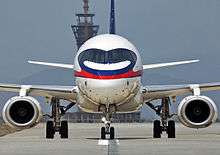
- On 9 May 2012 a Russian Sukhoi Superjet 100 airliner, on a demonstration flight with 37 passengers and eight Russian crew members on board, crashed after it took off from the Halim Perdanakusuma Airport in Jakarta, Indonesia, killing everyone on board. About twenty minutes after the take-off, the crew requested permission to descend to 6,000 feet (1,800 m), which was granted. This was the last contact that Air Traffic Control had with the aircraft, which was then about 139 kilometres (75 nmi) south of Jakarta, in the vicinity of the 2,211-metre-high (7,254 ft) Mount Salak, a mountain higher than the requested flight level.[123] After an extensive search, rescuers concluded, based on the widespread debris field on the side of a ridge, that the aircraft directly struck the rocky side of Mount Salak and there was "no chance of survival".[124][125] An official inquiry into the crash found that the plane's automatic collision avoidance system was working, but had been ignored by the pilot, who was possibly distracted by his conversation with a potential customer for the aircraft.[126][127]
- On 21 July 2013, a Russian Sukhoi Superjet 100 airliner, prototype aircraft RA-95005, unintentionally crash-landed gear-up at Keflavík International Airport near Keflavík, Iceland[128] when, during evaluation of the aircraft's automatic landing system, and its ability to land with a single engine while in a crosswind, the plane hit and slid down the runway with the gear up. The accident was blamed on pilot error, which was caused by severe fatigue. As a result, during an intended go-around, the pilot throttled up the wrong engine. Due to the plane's low-energy state, the plane continued to lose altitude, and, before the pilot realized his mistake, and throttled up the correct engine, it was too late, and the aircraft hit the runway.[129][130] One of the five crew on board was injured evacuating the aircraft. Nine safety recommendations were made by Iceland's Aircraft Accident Investigation Board, which investigated the accident.[131] The aircraft was repaired and it flew again on 27 December 2013.[132]
- On 10 October 2018, a Yakutia Airlines SSJ 100 airliner had slid off the runway at Yakutsk Airport as a result of the main landing gears of the aircraft collapsing. The aircraft had been operating flight R3414 from Ulan-Ude and had landed at 03:20 local time on 10 October. All 87 passengers and 5 crew members on board (according to Russian authorities, 91 according to the airline's initial figures) were safely evacuated and none were seriously injured, though four needed medical attention. Possible reasons for the accident included ice on the runway or the air strip’s poor state of repair, according to sources cited by Russian media. The runway was closed following the accident, re-opening at 10:30 for departures, although arrivals have been stopped while the Superjet is removed.[133][134]
See also
Related development
Aircraft of comparable role, configuration and era
Related lists
References
- Notes
- ↑ "Sukhoi Superjet-100" произвел свой первый полет Вести.Ru. Retrieved 3 January 2010.
- 1 2 Zaitsev, Tom. "Superjet 100 makes maiden flight." Flight International, 19 June 2008.
- 1 2 Guller, Christoph (15 December 2015). "SSJ-100 Production timeline". Retrieved 27 Jun 2017.
- 1 2 "Sukhoi Superjet 100 – Production list and backlog". Superjet100.info. Retrieved 1 May 2018.
- ↑ "SSJ-100 cost US$ 1.5 bln to create affirmed Mikhail Pogosian". ITAR-TASS News Agency. Retrieved 2013-02-07.
- ↑ ""Сухой" потратил $1,5 млрд, чтобы научиться у Boeing строить пассажирские лайнеры". Forbes.ru. 10 May 2011.
- ↑ "Трансаэро купит шесть самолетов Сухой Суперджет 100". Avioport.ru. 2012-02-17.
- 1 2 "Russia brings the Superjet to Pakistan". The Express Tribune. 9 May 2012. Retrieved 11 September 2018.
- ↑ Воробьев, Александр (2016-02-09). "Самолеты Sukhoi SuperJet подешевели почти в 2 раза" (in Russian). Ведомости.
- ↑ "List Prices". Sukhoi civil aircraft.
- ↑ "overview - Superjet International". www.superjetinternational.com. Retrieved 2018-05-07.
- ↑ "Comlux orders two Sukhoi Superjet 100 business jets". World Airline News. 10 October 2011. Retrieved 9 February 2016.
- ↑ SSJ100_Datasheet.pdf by SuperJet International
- ↑ "Sukhoi Superjet 100 Takes Off." Archived 12 October 2012 at the Wayback Machine. Kommersant. 19 May 2008.
- ↑ "Sukhoi Superjet 100 Project History, 2002." Sukhoi. Retrieved 9 May 2012.
- ↑ "Sukhoi Superjet 100 Project History: October 2003." Sukhoi. Retrieved 9 May 2012.
- ↑ "12 March 2004, Moscow – Superjet 100 Program Third Stage Completion."Sukhoi. Retrieved 9 May 2012.
- ↑ "Sukhoi Civil Aircraft Company's Board of Directors has officially affirmed the decision on the successful completion of the Fourth Program Phase." Sukhoi. Retrieved 9 May 2012.
- ↑ "A Government Contract For Research And Development Program on the Superjet 100 Aircraft Is Signed." Sukhoi. Retrieved 9 May 2012.
- ↑ Russia unveils new passenger jet Reuters, 26 September 2007.
- ↑ "Sukhoi Superjet systems can make up for any pilot mistake; UAC chief." Russia Today, 20 April 2011.
- 1 2 "Regional aircraft for international market." Russia & CIS Observer, 19 July 2010.
- ↑ "Russian industry special: New start for Sukhoi." Flight International, 13 August 2007.
- ↑ "SaM146." powerjet.aero. Retrieved 8 September 2011. Archived 29 April 2011 at the Wayback Machine.
- 1 2 3 Pyadushkin, Maxim. "Celebrating the 100th anniversary: The Sukhoi Superjet 100 makes its debut at Le Bourget." Russia & CIS Observer, Volume 2, Issue 25, 20 June 2009. Retrieved 9 November 2010.
- ↑ Pyadushkin, Maxim. "Right up there: Superjet 100 program needs more money to complete the certification." Russia & CIS Observer, Volume 4, Issue 27, 4 January 2009. Retrieved 9 November 2010.
- ↑ "New Orders but No Lift for Superjet." The Moscow Times, 27 July 2010.
- ↑ "Superjet-100 order book hikes by 50%." Russia Today, 16 June 2009.
- ↑ "Russia in force at Paris Air Show". Moscow Top News. 2010-05-07.
- ↑ "Russia unveils new passenger jet." Reuters. Retrieved 12 July 2011.
- ↑ "Russian Superjet 100 makes first test flight." Russian News and Information Agency via rian.ru, 19 May 2008. Retrieved 9 November 2010.
- ↑ "IL-76 LL The flying test bed for the SaM146 engine - www.redstar.gr". www.redstar.gr. Retrieved 2017-05-07.
- ↑ "News." Airliner World: 11.
- ↑ "First 13 flights." superjet100.com, July 2008. Retrieved 3 January 2010. Archived 15 August 2012 at the Wayback Machine.
- ↑ "25 Hours in the Air." superjet100.com, October 2008. Retrieved 9 November 2010. Archived 15 August 2012 at the Wayback Machine.
- ↑ "Second Sukhoi SuperJet 100 starts test flights." sukhoi.superjet100.com. Retrieved 3 January 2010. Archived 11 March 2012 at the Wayback Machine.
- ↑ "Second prototype took to the skies." sukhoi.superjet100.com. Retrieved 3 January 2010.
- ↑ Aviation Week & Space Technology, 29 October 2007, p. 66.
- ↑ "«Суперджет» задерживается" (Superjet delays) (in Russian). vremya.ru, 8 July 2008.
- ↑ "Russia Sukhoi sees Superjet delivery Q3 '09." Reuters. Retrieved 12 July 2011.
- ↑ "Video: First two Superjet 100s in formation flight." Flight International. Retrieved 3 January 2010.
- ↑ "Russia's Sukhoi Superjet-100 tested for long haul flight." mosnews.com. Retrieved 3 January 2010. Archived 27 September 2011 at the Wayback Machine.
- ↑ van Leeuwen, Marcel. "EASA pilots perform familiarization flights on board Sukhoi Superjet 100." aviationnews.eu, 19 April 2009. Retrieved 3 January 2010.
- ↑ Potter, Matthew. "The Third Sukhoi Superjet 100 Joins the Flight Test Campaign." defenseprocurementnews.com, 28 July 2009. Retrieved 24 April 2010.
- 1 2 3 "Sukhoi Superjet 100." themoscowtimes.com. Retrieved 24 April 2010. Archived 19 June 2009 at the Wayback Machine.
- ↑ "Superjet 100 indefinitely delayed." themoscowtimes.com. Retrieved 3 January 2010.
- ↑ Lake 2010, p. 59.
- ↑ "Superjet engines slice and dice birds." rt.com, 1 June 2010. Archived 13 August 2010 at the Wayback Machine.
- ↑ "Flight management system tests for Superjet 100 complete." RIA Novosti, 19 November 2010. Retrieved 19 November 2010.
- ↑ Nepomnyashchy, Alexei and Alexei Nikolsky. "Sukhoi Superjet behind schedule." themoscowtimes.com, 6 July 2010. Retrieved 9 November 2010.
- ↑ Buyck, Cathy. "SuperJet SSJ100 on track for November certification." ATW Online, 29 September 2010. Retrieved 9 November 2010.
- ↑ McHale, John. "Sukhoi Superjet 100 passes noise testing program." Military & Aerospace Electronics, 14 October 2010. Retrieved 3 November 2010. Archived 14 July 2011 at the Wayback Machine.
- ↑ "First Sukhoi Superjet 100 production aircraft flies for Armavia Airline." World Aeronautical Press Agency, 14 October 2010. Retrieved 9 November 2010.
- ↑ Zaitsev, Tom. "Superjet nears end of drawn-out certification campaign." Flight International via flightglobal.com, 11 November 2010. Retrieved 11 November 2010.
- ↑ "Russia's Superjet 100 moves closer to final certification." RIA Novosti, 21 December 2010. Retrieved 27 December 2010.
- ↑ "Superjet Receives Initial Type Certificate" Aviation Week, 3 February 2011. Retrieved 3 February 2011.
- ↑ "Sukhoi Superjet 100 gets Type Certificate from EASA." Superjet International.com, 3 February 2012.
- 1 2 3 4 Alan Dron (Nov 16, 2017). "Sukhoi to decide on new Superjet variant by 1Q 2018". Aviation Week Network.
- ↑ Stephen Trimble (21 Dec 2017). "Sukhoi starts testing first Superjet with 'Saberlets'". Flightglobal.
- ↑ David Kaminski-Morrow (14 May 2018). "Sukhoi assessing engine options for 'Russified' Superjet". Flightglobal.
- ↑ David Kaminski-Morrow (2 July 2018). "Sukhoi outlines sales expectations as it tweaks Superjet". Flightglobal.
- ↑ Vladimir Karnozov (July 9, 2018). "Kremlin Boosts Effort toward 'Indigenization' of SSJ100". AIN online.
- ↑ David Kaminski-Morrow (12 July 2018). "Sabrelet-fitted Superjet needs repair after test accident". Flightglobal.
- ↑ "INSIGHT: Review of United Aircraft Corporation's commercial projects". Russian Aviation Insider. 2018-08-15. Retrieved 2018-08-16.
- 1 2 3 Vladimir Karnozov (September 10, 2018). "Sukhoi, UAC Planning Superjet With No Western Content". AIN online.
- ↑ "Sukhoi Superjet 100 Production List". www.planespotters.net. Retrieved 2018-09-13.
- 1 2 "Sukhoi Superjet 100 heading from Yerevan lands at Sheremetyevo airport." NEWS.am, 21 May 2011.
- ↑ "Sukhoi Superjet 100 makes first passenger flight." Archived 24 April 2011 at the Wayback Machine. Voice of Russia, 21 May 2011.
- 1 2 3 4 Karnozov, Vladimir. "Pictures: Armavia Superjet conducts first revenue flight." Flight International, 21 May 2011.
- 1 2 Zorembo. Igor. "Sukhoi Superjet conducts first passenger flight." RIA Novosti, 21 May 2011.
- ↑ "Russia's Sukhoi Superjet 100 to make first passenger flight on April 12." GSS, 21 April 2011. Archived 23 March 2012 at the Wayback Machine.
- ↑ "RIAN – Armavia Returns Superjet-100 to Manufacturer". Retrieved 14 November 2014.
- ↑ "The Sukhoi Superjet 100 landed in Venice for the first time." superjetinternational.com, 1 May 2011. Retrieved 8 September 2011.
- ↑ "«Аэрофлот» выторговал у «Гражданских самолетов Сухого» беспрецедентные скидки". Vedomosti, 13 May 2012.
- ↑ "UAC :: News :: For Mass Media: about Sukhoi Superjet 100 commercial operation". Uacrussia.ru. Archived from the original on 10 February 2013. Retrieved 9 February 2013.
- ↑ "Interjet SSJ100 confirm successful operations". Traveldailynews.com. Archived from the original on 4 November 2013. Retrieved 7 November 2013.
- ↑ "Новости Aviation EXplorer: За первый месяц эксплуатации 2 самолета Sukhoi SuperJet 100 авиакомпании Interjet показали среднесуточный налет 9,74 часа". Aex.ru. Retrieved 2013-11-07.
- ↑ "UAC :: News :: Interjet SSJ100 confirms successful operations". Uacrussia.ru. 18 September 2013. Archived from the original on 29 November 2014. Retrieved 7 November 2013.
- ↑ "Interjet's Supejet Dispatch Nearly Perfect | Things With Wings". Aviation Week. Retrieved 2014-06-12.
- ↑ "Owner of Armenian Armavia rejects alleged debt for Sukhoi SuperJet 100". Arka.am. 2012-12-19. Retrieved 2013-02-09.
- ↑ Our Fleet, Armavia corporate website, Yerevan, Undated. Retrieved 3 February 2013. Archived 11 January 2013 at the Wayback Machine.
- ↑ Interjet Starts Monterrey – Houston Service from late-Oct 2014 RoutesOnline.com, 4 September 2014
- ↑ "Superjets flying over USA"SdelanoUNas.ru (in Russian), 12 September 2014
- ↑ https://www.interjet.com, Flight Schedules
- ↑ "Russia Grounds Its Newest Airliner Over Safety Concerns". The New York Times. 24 December 2016. Retrieved 24 December 2016.
- ↑ "Sukhoi Superjet 100 Fleet Inspection Completed/27.12.2016 – Sukhoi Civil Aircraft". Scac.ru. 2016-12-27. Retrieved 2017-06-05.
- ↑ Sputnik (2016-12-27). "Mexican Airline Interjet Checking Russian Superjet 100 Planes After Warning". Sputniknews.com. Retrieved 2017-06-05.
- ↑ "Superjet reliability close to 98%: Sukhoi". FLIGHT. 17 Aug 2017.
- ↑ "EASA Safety Publications Tool". ad.easa.europa.eu. Retrieved 2017-07-24.
- ↑ Andrea Navarro (12 Jan 2018). "Stranded Russian Jets in Mexican Hangars Haunt Troubled Airline". Bloomberg.
- ↑ "Mexico's Interjet refutes media reports it's 'cannibalizing' SSJ-100 planes". TASS. 19 Jan 2018.
- ↑ "Interjet приостановила эксплуатацию части парка SSJ 100" (in Russian). ATO.ru. 17 January 2018.
- ↑ Maxim Pyadushkin and Jens Flottau (Sep 20, 2018). "Superjet Faces Western Airline Pushback, But Aeroflot Wants More SSJs". Aviation Week & Space Technology.
- ↑ "Sukhoi Faces Loss Of Rare Western Customer". MRO Network. 11 September 2018. Retrieved 11 September 2018.
- ↑ "Press Release" (PDF) (Press release). Interjet. September 12, 2018.
- ↑ Ghim-Lay Yeo (14 Sep 2018). "Interjet to phase out some Superjets in fleet restructuring". Flightglobal.
- ↑ Vladimir Karnozov (September 17, 2018). "Mexico's Interjet Alters Growth Plan, To Shed some SSJ100s". AIN online.
- ↑ Ghim-Lay Yeo (2 Oct 2018). "ANALYSIS: Sukhoi offers Superjet upgrades to appease Interjet". Flightglobal.
- ↑ Edward Russell (17 Nov 2017). "Interjet praises Superjet despite continuing maintenance needs". Flightglobal.
- ↑ Paul Jebely (March 18, 2015). "Paper planes: the financing of aircraft pre-delivery payments". Clyde & Co.
- ↑ "Commercial Aircraft New Airbus aircraft list prices for 2012" (Press release). Airbus. 18 January 2012.
- ↑ Alan Dron (17 September 2018). "Brussels Airlines looks at wet-lease options for Sukhoi aircraft". ATWOnline.
- ↑ "Sukhoi to cut Superjet deliveries and focus on aftersales support". Russian Aviation Insider. 2018-10-01. Retrieved 2018-10-04.
- 1 2 Jens Flottau, Maxim Pyadushkin and Michael Bruno (Jan 2, 2018). "MC-21 Narrowbody Flight Tests Symbolize Russian Sector Ambitions". Aviation Week & Space Technology.
- 1 2 David Kaminski-Morrow (21 May 2018). "Shrunk Superjet to have more commonality with MC-21". Flightglobal.
- ↑ Kingsley-Jones, Max (6 February 2007). "Russian Revolution: The Sukhoi Superjet". Flight International.
- ↑ "All SSJ100 in Light Specification to be Replaced by Full in the First Half of 2014" (Press release). Superjet International. January 30, 2014.
- ↑ "All Light SSJ100 of Aeroflot Replaced with the Full Version" (Press release). Superjet International. June 30, 2014.
- 1 2 Vladimir Karnozov. "Superjet's 130NG Stretch To Feature Composite Wing | Aviation International News". Ainonline.com. Retrieved 2012-08-24.
- ↑ "Russia and Italy planning new 130-seat regional jet". Flightglobal.com. 2012-02-07. Retrieved 2012-08-24.
- 1 2 Russia will start the production of Sukhoi SuperJet NG in 2019-2020 ruaviation.com, 2 August 2013. Retrieved 23 November 2013.
- ↑ "Russia-now". Russia-now.info. Retrieved 2013-01-04.
- ↑ "UAC to Build New 140-Seat Airliner | Business | RIA Novosti". En.rian.ru. Retrieved 2012-08-24.
- ↑ "Russia will start the production of Sukhoi SuperJet NG in 2019–2020". Russian Aviation. 2 August 2013.
- ↑ "Sukhoi plans 120-seat SSJ stretch". Air Transport World. Aviation Week Network. October 12, 2016.
- ↑ Polina Montag-Girmes (Jun 20, 2017). "UAC to make a decision on 130-seat SSJ100 in 2017". Aviation Week Network.
- ↑ Polina Montag-Girmes (Jun 23, 2017). "PowerJet ready to develop SaM146 engines for 130-seat SSJ100". Aviation Week Network.
- ↑ Max Kingsley-Jones (6 Feb 2018). "Sukhoi considering PW1000G power for Superjet shrink". Flightglobal.
- ↑ Bjorn Fehrm (February 7, 2018). "Next Sukhoi Superjet is a 75 seater". Leeham.
- ↑ David Kaminski-Morrow (3 July 2018). "Sukhoi leans towards composite wing on 75-seat Superjet". Flightglobal.
- ↑ Superiority the new benchmark SSJ100/95 www.superjetinternational.com
- ↑ "SSJ100 Datasheet" (PDF). Retrieved 7 December 2017.
- ↑ "Russia’s Sukhoi SuperJet-100 goes off radars in Jakarta, hijacking not ruled out." RT, 9 May 2012. Retrieved 11 May 2012.
- ↑ " 'No sign of survivors' at Sukhoi SuperJet-100 wreck site." RT, 10 May 2012. Retrieved 10 May 2012.
- ↑ Salna, Karlis. "No survivors in Indonesia plane crash." 9 News, 10 May 2012. Archived 19 July 2012 at the Wayback Machine.
- ↑ Archived 21 December 2012 at the Wayback Machine.
- ↑ "Superjet Pilots Blamed For Indonesia Crash". Avweb.com. Retrieved 2012-12-20.
- ↑ "Flugvél brotlenti á Keflavíkurflugvelli". mbl.is. Retrieved 2013-07-21.
- ↑ "Accident: Sukhoi SU95 at Keflavik on Jul 21st 2013, belly landing". Retrieved 2016-03-30.
- ↑ Kaminski-Morrow, David. "Fatigued Superjet test pilot used wrong throttle before crash". Flightglobal. Retrieved 30 March 2016.
- ↑ "Report on aircraft accident" (PDF). Rannsóknarnefnd samg önguslysa. Retrieved 26 March 2018.
- ↑ "Repair of the SSJ100 s/n 95005 in Keflavik". Superjet100.info. 16 Jan 2014.
- ↑ Editorial, Reuters. "Passenger plane rolls off runway on landing in Siberia". U.S. Retrieved 2018-10-10.
- ↑ "Yakutia Superjet damaged in Yakutsk landing excursion". Flightglobal.com. 2018-10-10. Retrieved 2018-10-10.
- Bibliography
- Lake, Jon. "Russia's Regional Jet". Air International, Vol. 78, No. 5, May 2010, pp. 54–60. Stamford, UK: Key Publishing. ISSN 0306-5634.
External links
| Wikimedia Commons has media related to Sukhoi Superjet 100. |
- Official website
- Unofficial production list and backlog
- "Superjet 100 Brochure" (PDF). Sukhoi. 2016.